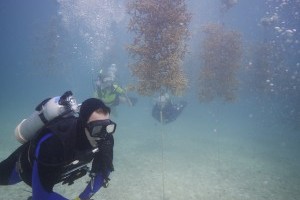
Florida Keys Marine Field Operations
Understanding processes and environmental factors that influence coral reef health.
1600 Ken Thompson Parkway
Sarasota, FL 34236
Ph: (941) 388-4441
Hours: 10AM - 5PM
A 501(c)3 nonprofit organization.
 Sharks and rays have inhabited the oceans and some freshwater systems for hundreds of millions of years and constitute a diverse group of sophisticated predators. Mote scientists including our Founding Director, Dr. Eugenie Clark, and former Lab Director Perry W. Gilbert pioneered research into the biology of these fascinating animals from the 1950s. Early studies ranged from basic descriptions of the local species to ground-breaking studies of shark learning and sensory biology. Subsequent Mote research has harnessed emerging technologies to gain an even more comprehensive picture of their lives, ranging from how they are able to avoid hurricanes to how different species reduce competition by being active at different times. Today we study sharks and rays using an array of tools, including DNA, electronic tracking devices, bio-loggers, and animal-borne cameras. Some of our main research questions include:
Sharks and rays have inhabited the oceans and some freshwater systems for hundreds of millions of years and constitute a diverse group of sophisticated predators. Mote scientists including our Founding Director, Dr. Eugenie Clark, and former Lab Director Perry W. Gilbert pioneered research into the biology of these fascinating animals from the 1950s. Early studies ranged from basic descriptions of the local species to ground-breaking studies of shark learning and sensory biology. Subsequent Mote research has harnessed emerging technologies to gain an even more comprehensive picture of their lives, ranging from how they are able to avoid hurricanes to how different species reduce competition by being active at different times. Today we study sharks and rays using an array of tools, including DNA, electronic tracking devices, bio-loggers, and animal-borne cameras. Some of our main research questions include: